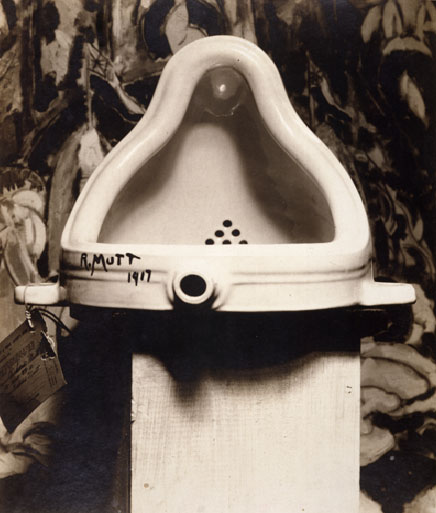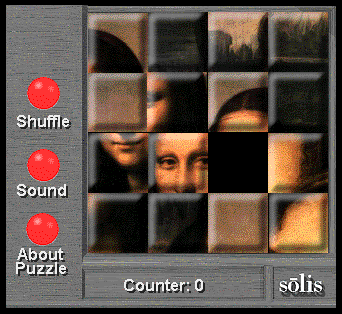 |
| "Fountain"-urinal- Ready made 1917 by Marcel Duchamp |
Take Duchamp's other famous work "L.H.O.O.Q."-a mastache added to Mona Lisa-for example. A few pen marks in mockery around the mouth of the world's madonna, Mona Lisa, soon drew people's attention. Duchamp never took the time like Leonardo Da Vinci to paint that woman. Instead, he put a few pen marks on a great artwork. Is it so great because he did something that nobody would dare do?? Would his work be as influencial if Duchamp cut Mona Lisa in pieces and rearranged it like the shift puzzle shown below, as suggested in The Cut-UP method? Is it really about the mustache, or is it the modification on a great artwork?
 |
| L.H.O.O.Q. by Marcel Duchamp |
 |
| Mona Lisa Shift Puzzle |
The question is raised to the next level when the artist whose art was stolen by another artist is still alive. What I mean here is, that Leonardo Da Vinci did not exist when Duchamp took Mona Lisa and mocked it and claimed it his own work. It is a different case for Richard Prince's series of Cowboy photographs: Untitled (Cowboy). Prince went ahead and took a series of photos of photos of an American cowboys in Marlboro cigarette ads in a magazine. Prince's beautifully edited photos decided to jump out of the magazine and brought fortune to Prince. Prince did not take the time and money to travel down to Texas to shoot real life cowboys. He did not hire and pay models to be cowboys in the wilderness. He simply took pictures of an already existing photographs. I was very curious in how the original photographer felt about all this, and was able to find a short clip of Sam Abell, the original photographer of the Marlboro cowboys. It is interesting to see his reactions on Prince's photos of the cowboys. "I'm not angry, of course...I'm not particularly amused...I'm thoughtful about it," says Abell in the interview. Calling him a "cheeky fellow," Abell is very curious in what was going on in Prince's mind when he decided to copy his works and make money out of it. He also states that it is a plagiarism. He talks about the reality of the Art World-how his works will never make that much fortune and will never make it to famous exhibitions and galleries. It's because he is an editorial photographer. Not a famous artist like Prince.
Here again, the question of what "good art" means is brought up. What determines a good art? Is it the newness of the idea? The creative idea that makes it "good"? The movie, Decasia, by Bill Morrison is a chain of decaying films of random, once lost footages. By carefully combining them in well-planned order, by having a reoccuring theme (wheels and spins), and by putting it over a carefully composed music by Michael Gordon to add effects, the 67 minutes films composed of short decayed footages successfully grasped the art world's attention. Who would have thought of such an idea? Fresh and new! Creative!
What is "good art"? Today, borrowing and lending bits and pieces of artwork is inevitable. It just happens due to the accessibility of eachother's artworks. If the artist claims it an art, and if the world buys it, you become famous. If you are not famous already and your artworks get stolen, you just have to live with it. However, I strongly believe that it is problematic if the artist fails to acknowledge the sources of where the original came from and if the source, especially if he/she is still alive, is not happy about it. Then, famous or not, it is a plagiarism.
To me the art world is irrational. You cannot put a rule nor can you find a norm in it. One thing is certain, if you are famous, people will buy your "art" or whatever it is that you are selling. The quality does not effect the demand but the demand does. What I am trying to say is if a lot of people wants your art, many more will. I guess it is like fashion? Sometime I look at a certain new fashion in clothing and ask myself why would anyone in the right mind buy it? But when a TV movie star worn it, the cloth popped up everywhere. So if you want to sell your art or become a "good" artist, make yourself famous is your first priority!
ReplyDeleteMaki, I completely understand what you are trying to say about the complexity of artists wanting to share their work. On one side, they are compelled to publicize their work, whether it be on the internet, in magazines, or at exhibitions. Yet, on the other side, they are insecure and aware that once their work is out there, it will no longer be only theirs. This situation also brings out the use of Fair Use and Copyright Laws, which only allow limited use of copyrights material without requiring permission from the rights holders. However, personally, these laws seem pointless to me because they are so ambiguous and general. How are we supposed to know what "limited" means in this context. Also, since plagiarism is so common today, it seems quite impossible for these laws to be able to stop or even catch these criminals who steal so discreetly. The authority cannot simply keep an eye on everyone ALL the time to make sure no one is stealing another's work!
ReplyDeleteWhat Duchamp and Prince and Morrison were putting forth a new idea by "reframing" objects and images in a new contemporary context. By recropping the cowboys and making them into "paintings" in a gallery or signing and tipping over a urinal and displaying it as sculpture, it makes the viewer rethink a whole set of assumptions. Some of these artists got famous because of these works rather than the works getting attention because they are by famous artists. Consider the timing! The fountain is from 1919 and the cowboys from the 1980s! That's a long time to get "famous"...
ReplyDelete